What Are Bipolar Forceps? A Complete Surgical Guide to Types, Functions, and Safe Use in Modern Electrosurgery

These forceps are vital in delicate procedures. They are commonly used in neurosurgery and ENT operations.
Their design allows for controlled electrical current flow.
Bipolar forceps differ from monopolar instruments. They offer more precision and less thermal spread.
This makes them ideal for sensitive surgeries.
Bayonet bipolar forceps are a popular type. Their angled design provides better visibility.
This is crucial in deep or narrow surgical sites.
Cleaning and maintenance are key for these instruments. Proper care prevents infection and maintains
their integrity. This ensures they function effectively during surgery.
Surgeons must be trained in their use. This ensures patient safety and optimal outcomes. Regular
inspection is also necessary.
Bipolar forceps have advanced surgical techniques. They offer precision and control. This has
improved surgical outcomes significantly.
Understanding these tools is crucial for medical professionals. They are a staple in surgical instrument trays.
Their role in modern surgery is indispensable.
Understanding Bipolar Forceps Function and Usage
Bipolar forceps are specialized surgical instruments. They are designed to conduct electrical current
between two tips. This allows for precise tissue coagulation.
Unlike monopolar instruments, bipolar forceps limit electrical spread. This precision reduces collateral
tissue damage. It is crucial in operations involving critical areas.
The key function of these forceps is coagulating blood vessels. They help control bleeding during surgery.
This is essential for patient safety and surgical success.
Bipolar forceps connect to an electrosurgical generator. The generator regulates the current flow.
This control is vital for delicate procedures.
These forceps are versatile and used in various surgical fields. They are common in neurosurgery,
where precision is paramount. ENT surgeries also benefit from their use.
Several features enhance their function:
- Two tips conduct electrical current.
- Controlled current prevents excessive heat spread.
- Versatile design suits many surgical specialties.
Bipolar forceps have become indispensable in modern medicine. Their ability to minimize
damage is unmatched. This makes them a top choice for surgeons globally.
Key Features and Benefits of Bipolar Forceps
Bipolar forceps offer several key advantages. They are engineered for precision and control.
This is essential for delicate surgical procedures.
A significant benefit is the ability to limit thermal spread. By directing current between two tips,
surrounding tissue remains unharmed. This reduces postoperative complications significantly.
Their design aids visibility during surgery. Especially in confined or complex areas, this feature
is valuable. Improved access and line of sight are crucial for surgical success.
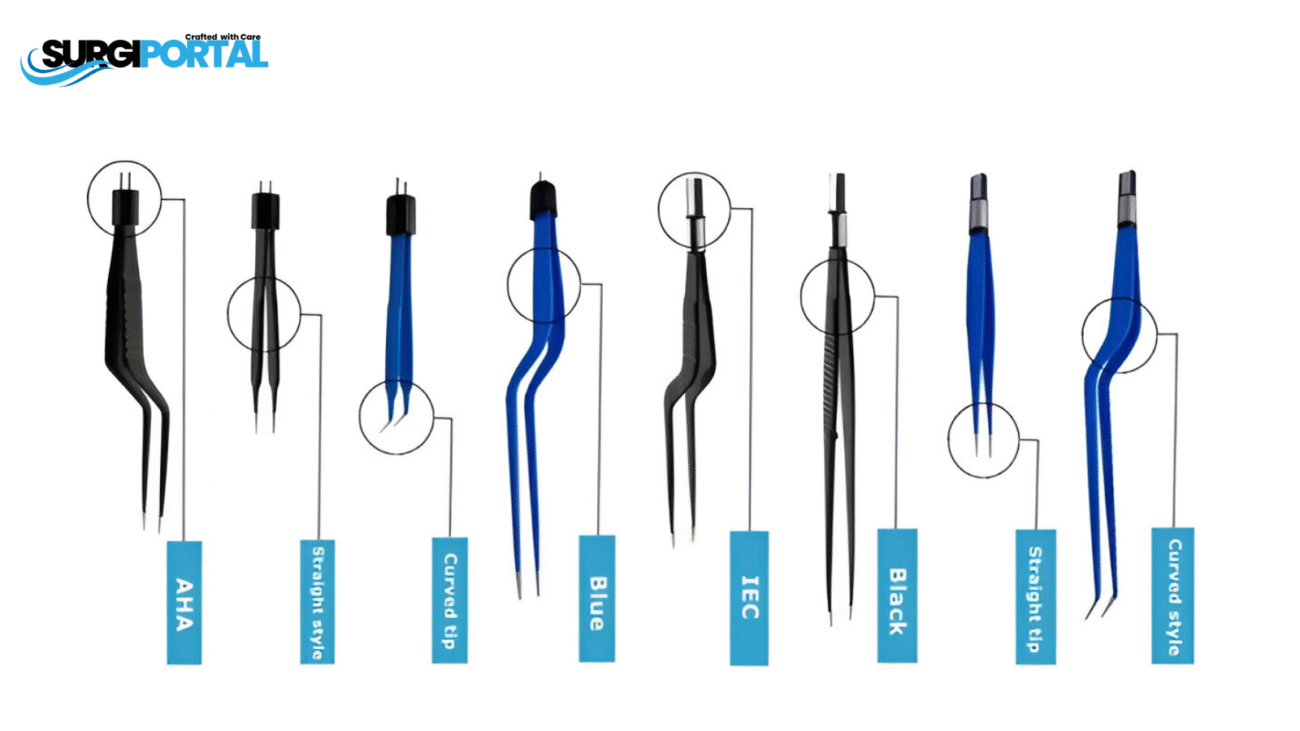
Bipolar forceps also enhance surgical ergonomics. Surgeons experience less fatigue,
even during lengthy operations. This promotes better surgical outcomes and efficiency.
Here are some notable features:
- Precision in tissue coagulation
- Minimal thermal spread
- Enhanced surgical site visibility
- Ergonomic design for reduced fatigue
- Versatility in various surgical fields
These forceps prove indispensable in modern surgery.
Their design advances patient safety and operational efficiency.’
For many surgical teams, they are a staple tool.
Types of Bipolar Forceps
Bipolar forceps come in various forms, each suited to specific needs.
Their design variations enable precision across different procedures.
Understanding these types helps choose the right tool for surgery.
1. Standard Bipolar Forceps
Standard bipolar forceps are the most widely used electrosurgical instruments in bipolar coagulation. They feature straight or slightly curved shafts with smooth, serrated, or fine-point tips, offering dependable performance across a range of general and specialty surgeries. Unlike monopolar systems, standard bipolar forceps pass electrical current only between the two tips, allowing for targeted coagulation with minimal thermal spread to surrounding tissues.
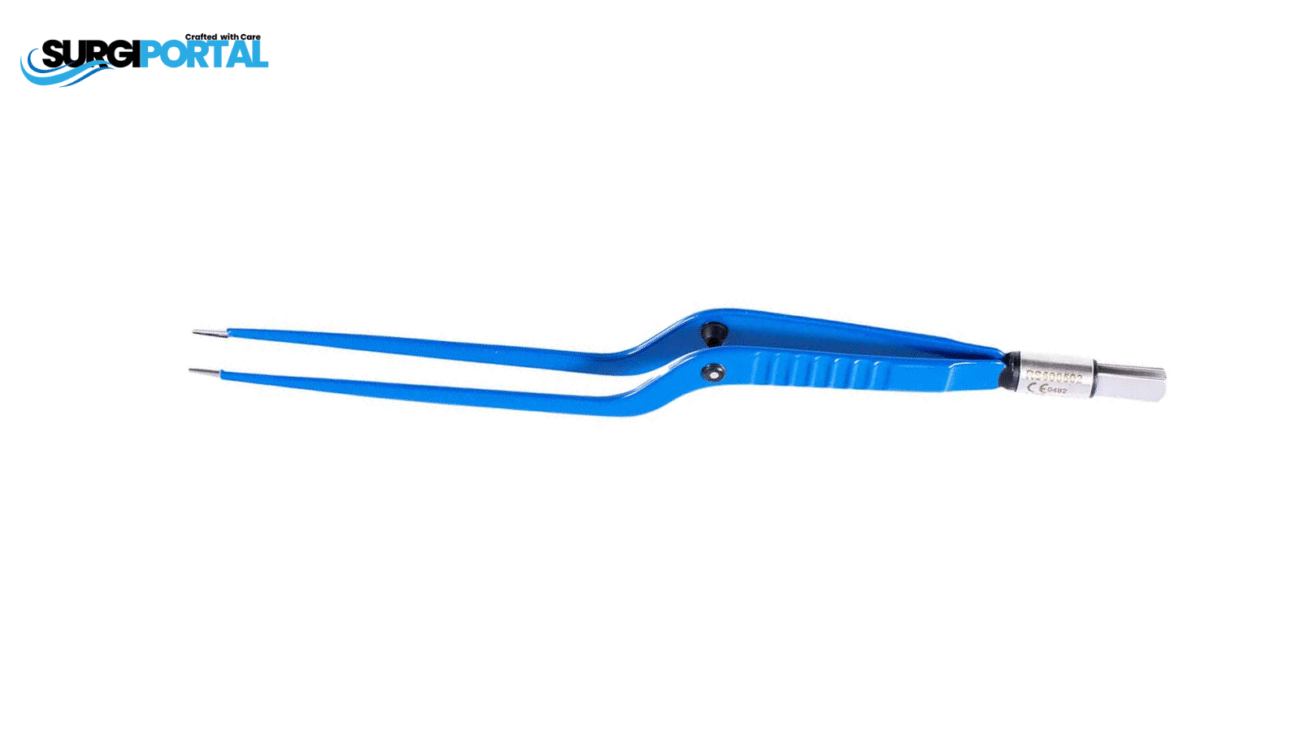
Design: Straight or angled tips with smooth or serrated jaws.
Use: General surgeries, neurosurgery, ENT, plastic surgery.
Material: Usually stainless steel or titanium.
Features: Reusable, compatible with most electrosurgical generators.
2. Non-Stick Bipolar Forceps
Non-stick bipolar forceps are advanced electrosurgical instruments designed with special tip coatings typically silver alloy, ceramic, or gold-plated materials—that prevent tissue from adhering during coagulation. Sticking is a common issue in bipolar electrosurgery caused by protein denaturation and heat buildup. Non-stick technology addresses this by enhancing heat dissipation and reducing char buildup.
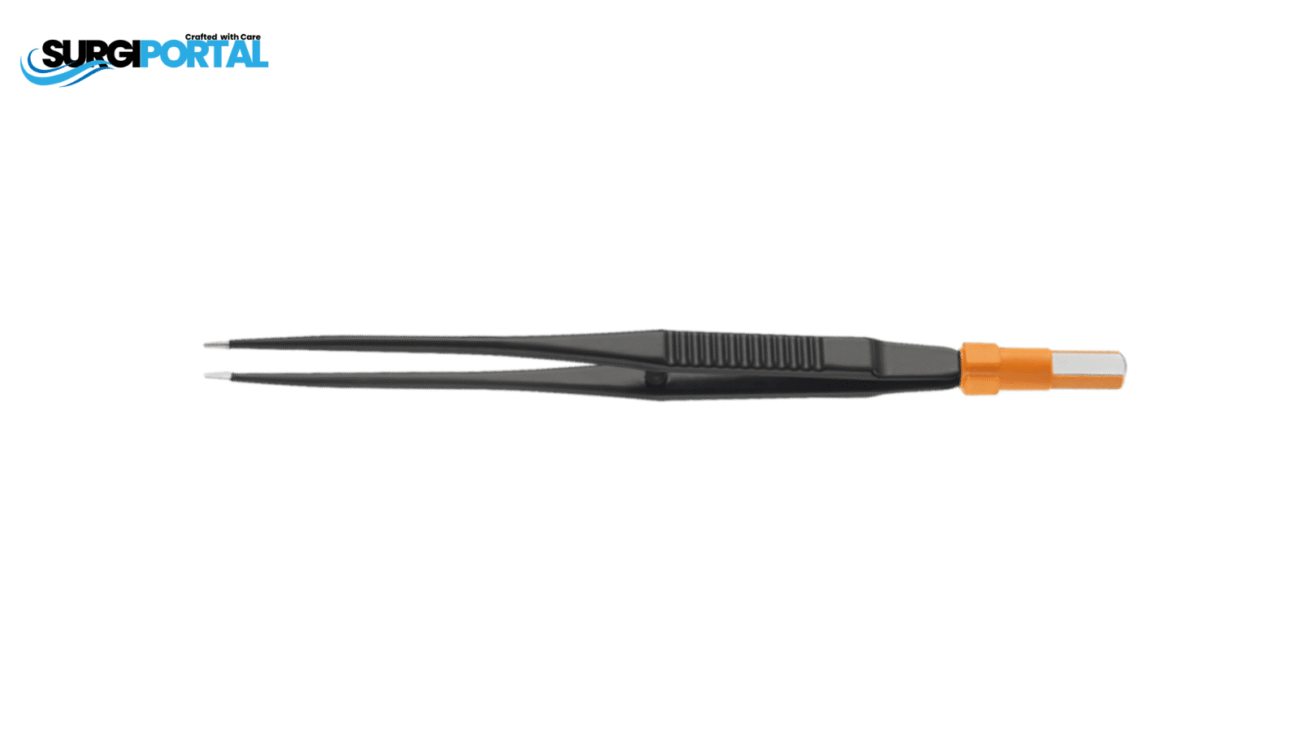
Benefit: Cleaner, faster surgeries with minimal tissue trauma
Design: Coated with silver or ceramic tips.
Use: Neurosurgery, microsurgery, plastic surgery.
Purpose: Prevents tissue from sticking to the tips during coagulation.
3. Bayonet Bipolar Forceps
Bayonet bipolar forceps are uniquely designed with a bayonet shaped shaft meaning the handle and tips are offset allowing the surgeon to maintain a clear line of sight to the surgical field. This design is especially valuable in procedures where deep or narrow access is required, such as neurosurgery, ENT (ear, nose, throat) surgery, and spinal operations.
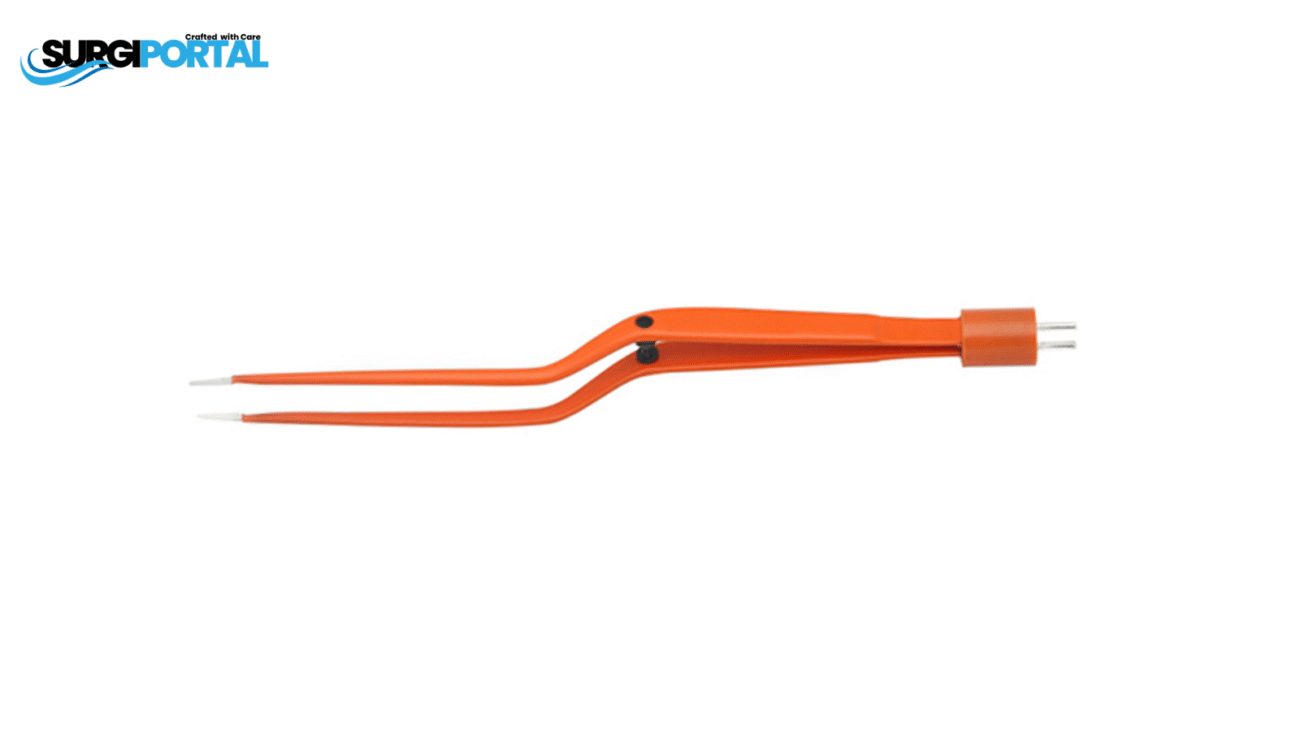
Design: Bayonet-shaped shaft for deep or narrow access.
Use: ENT, spinal surgery, brain surgery.
Benefit: Provides excellent visibility by offsetting the surgeon’s hand.
4. Irrigating Bipolar Forceps
Irrigating bipolar forceps are specialized electrosurgical instruments that combine traditional bipolar coagulation with built-in irrigation capability. These forceps feature internal channels that deliver continuous or controlled saline irrigation directly to the surgical site, especially around the electrode tips. This design helps to cool the tissue, reduce thermal injury, and improve coagulation efficiency making them invaluable in delicate surgeries like neurosurgery and microvascular procedures.
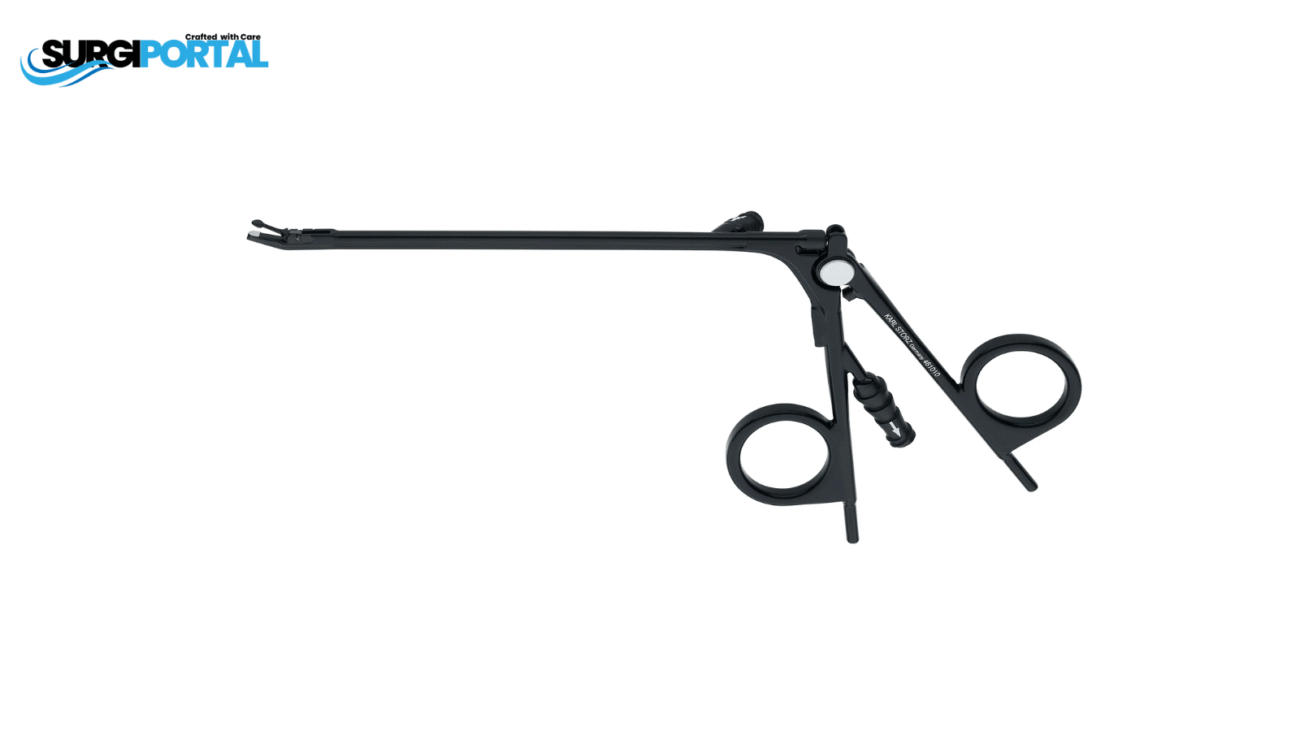
Design: Built-in channels allow saline or fluid irrigation at the tip.
Use: Neurosurgery, delicate tissue procedures.
Advantage: Prevents heat buildup and burns by cooling the tip and tissue.
5. Disposable Bipolar Forceps
Disposable bipolar forceps are single-use, sterile electrosurgical instruments designed for safe and efficient bipolar coagulation without the need for reprocessing. These forceps are made from medical-grade polymer materials combined with conductive metal tips, offering a practical solution for clinics and hospitals that prioritize infection control, cost-efficiency, or high patient turnover.
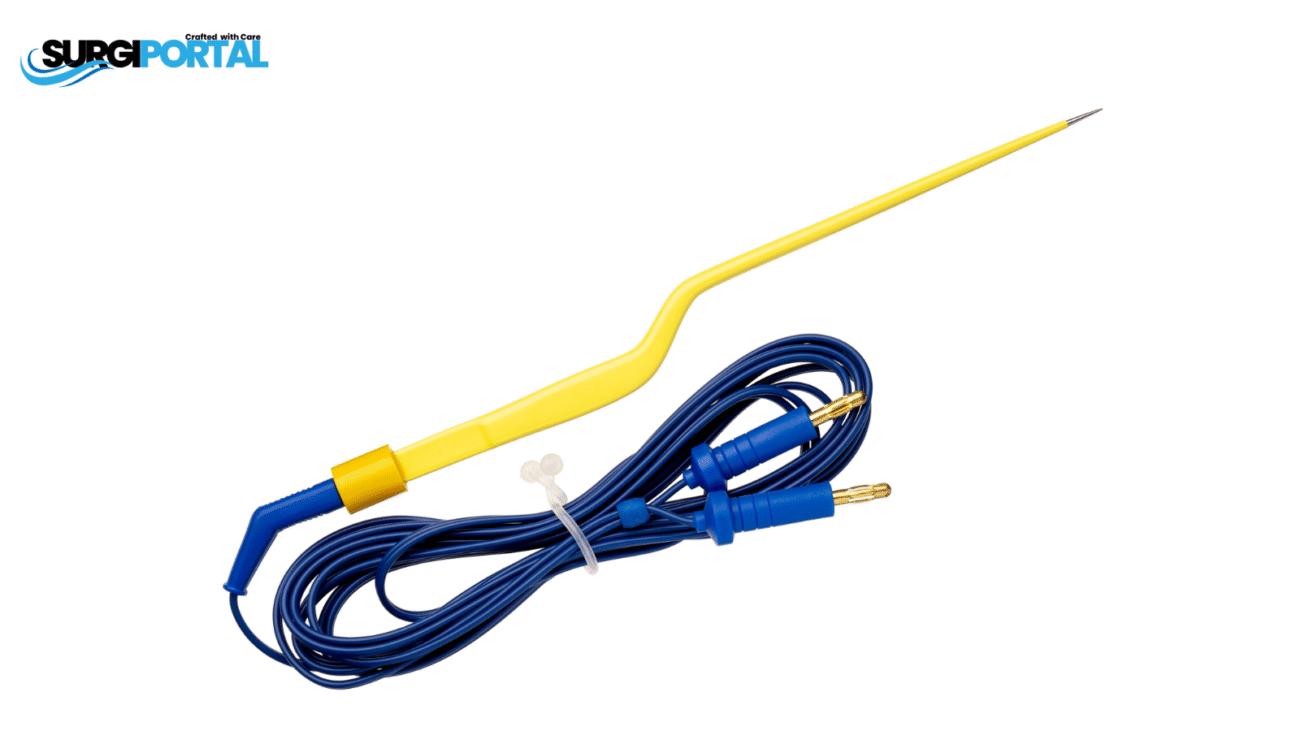
Design: Single-use sterile instruments.
Use: Outpatient surgeries, infection control situations.
Material: Medical-grade plastic with conductive metal tips.
Benefit: Saves reprocessing time and eliminates cross-contamination risk.
Bayonet Bipolar Forceps with their Design and Advantages
Bayonet bipolar forceps stand out for their distinct design. The angled shape resembles a bayonet,
offering specific surgical advantages. This design is particularly helpful in deep surgical fields.
A primary benefit is improved visibility. The angle allows unobstructed views of the operative site.
Surgeons can perform with higher precision and confidence.
These forceps also contribute to ergonomic handling. Their form reduces strain on the surgeon’s wrist.
This is beneficial during long, intricate surgeries.
They excel in sensitive procedures, such as neurosurgery and ENT. Their precise control minimizes the
risk of unintended tissue damage. Hence, they are a preferred tool in delicate operations.
Key advantages of bayonet bipolar forceps include:
- Enhanced visibility and access
- Reduced hand fatigue
- Precise control in sensitive areas
- Versatility across surgical applications
- Preferred use in specialized fields
Bayonet bipolar forceps are invaluable in many surgical settings. Their unique design leads to
better surgical performance. For surgeons, they are essential in providing safe and effective care.
Table Guide on types of Bipolar Forceps
| Type | Best Used In | Tip Design | Reusable/Disposable | Key Benefit |
|---|---|---|---|---|
| Standard Bipolar Forceps | General, Neuro, ENT, Plastic | Straight/Angled | Reusable | Versatile and widely compatible |
| Non-Stick Bipolar Forceps | Neurosurgery, Plastic | Coated Tips | Reusable | Prevents sticking, improves hygiene |
| Bayonet Bipolar Forceps | ENT, Brain, Spine | Bayonet-shaped | Reusable | Clear field of view |
| Irrigating Bipolar Forceps | Neurosurgery, Microsurgery | Straight w/ Port | Reusable | Reduces thermal injury |
| Disposable Bipolar Forceps | Outpatient, Single-use procedures | Varies | Disposable | Infection control, convenience |
| Micro Bipolar Forceps | Ophthalmic, Microvascular, Pediatric | Very Fine Tips | Reusable | Ultra-precise coagulation |
Common Surgical Applications of Bipolar Forceps
Bipolar forceps are a staple in many surgical disciplines. Their primary role is in procedures
requiring precision and minimal thermal spread. They excel in surgeries where delicate
tissue management is crucial.
In neurosurgery, bipolar forceps are indispensable. They offer the control needed to navigate
sensitive brain tissues. The precision helps avoid damaging critical areas.

They are also widely used in ENT surgeries. These procedures often involve narrow passages
and complex anatomy. Bipolar forceps provide the accuracy required for these delicate operations.
Gastrointestinal surgeries often benefit from bipolar forceps. Their use helps control bleeding
efficiently. This aids in maintaining clear visibility throughout the procedure.
Another vital application is in spinal surgeries. Bipolar forceps assist in precise tissue manipulation
around the spinal cord. Such accuracy is critical to avoid postoperative complications.
Key surgical applications include:
- Neurosurgery
- ENT procedures
- Gastrointestinal surgeries
- Spinal surgeries
- Microsurgery in various fields
Bipolar forceps play a crucial role across these surgical domains. Their precision and versatility
make them an essential tool for modern surgeons. As a result, they significantly contribute to
improved surgical outcomes.
How to Use Bipolar Forceps Safely and Effectively
Using bipolar forceps requires skill and attention. Proper handling ensures both safety and
effectiveness during surgical procedures. Familiarize yourself with the instrument before use.
Select the appropriate type of bipolar forceps for the procedure. The right choice depends on
the surgical field and specific requirements. Consider factors like tip configuration and size.
Ensure that the forceps are properly connected to the electrosurgical generator. This connection
is crucial for consistent performance. Adjust the electrical settings according to tissue type and
surgical goals.
Regularly inspect the forceps during the procedure. Check for alignment and functionality.
Any issues should be addressed immediately to prevent complications.
Safety and effectiveness involve:
- Thorough knowledge of the instrument
- Proper selection and connection
- Adjustment of electrical settings
- Regular inspection during use
These steps are essential for patient safety. They also ensure optimal surgical outcomes.
Understanding these practices can make a significant difference in the success of procedures.
When Using a Bayonet Bipolar Forceps
Bayonet bipolar forceps are unique. Their angled design offers specific advantages. These need
to be harnessed properly for optimal performance.
Align the tips correctly before beginning. Proper alignment helps in delivering precise electrical
energy to target tissues. It also minimizes the risk of unwanted tissue damage.
Hold the bayonet forceps with a relaxed grip. This reduces hand fatigue during lengthy operations.
A steady hand can significantly enhance precision.
Practice using magnification tools. Bayonet forceps often work best with enhanced visual aids. This
combination further increases precision and effectiveness.
Key best practices include:
- Correct tip alignment
- Relaxed hand grip
- Use of magnification tools
- Consistent monitoring during the procedure
These practices enhance the utility of bayonet bipolar forceps. They improve visibility and control
during surgery. Following these guidelines ensures better surgical performance.
How to Clean Bipolar Forceps: Step-by-Step Guide
Proper cleaning of bipolar forceps is essential. It prevents infection and maintains instrument quality.
Always follow recommended protocols for cleaning.
Begin by rinsing the forceps under running water. This removes blood and debris. Use room temperature
or warm water for best results.
Manual scrubbing is next. Use a soft brush and mild detergent. Focus on the tips and joints to remove
stuck materials.
Ultrasonic cleaning can be beneficial. This process reaches tiny crevices. It provides a deeper clean than
manual scrubbing alone.
Sterilization is crucial after cleaning. Place the forceps in an autoclave. Follow specific guidelines
for temperature and duration.
For effective cleaning:
- Rinse under running water
- Manual scrub with a soft brush
- Use ultrasonic cleaning for thoroughness
- Sterilize in an autoclave
Remember to inspect the forceps after cleaning. Check for any residue or damage.
Proper maintenance extends the life of the instrument and ensures optimal performance
during surgeries.
Maintenance, Inspection, and Storage Tips
Routine maintenance is vital for bipolar forceps longevity. It also ensures they function effectively.
Regular inspection should be part of the process.
Examine the forceps for any damage. Check the tips for wear or misalignment.
Damaged tips can hinder performance.
Consistent storage practices matter too. Store forceps in a dry, cool place.
Always use protective covers or trays.
Follow these tips for optimal care:
- Inspect tips for damage
- Ensure proper alignment
- Store in a cool, dry area
- Use protective covers
By adhering to these guidelines, you prolong the life of your bipolar forceps.
This attention to care ultimately aids in achieving surgical success through the
reliable performance of your instruments.
Innovations and Advances in Bipolar Forceps Technology
Recent years have seen significant innovations in bipolar forceps technology. These
advancements aim to improve surgical precision. They also focus on enhancing safety
during procedures.
New materials have led to the development of more durable forceps. Non-stick coatings have been introduced. These coatings minimize tissue adhesion and
improve performance.
Design modifications continue to evolve. Ergonomic handles reduce surgeon fatigue.
Enhanced tip configurations allow better access during surgery.
Key innovations include:
- Non-stick coatings to reduce sticking
- Ergonomic designs for comfort
- Advanced tip configurations for accessibility
These technological advancements enhance the efficiency and safety of surgical
procedures. As technology progresses, more improvements are anticipated to further
benefit surgical practices worldwide.
Frequently Asked Questions About Bipolar Forceps
Bipolar forceps are common in many surgeries, leading to several frequently asked
questions. Below are some of the common queries.
What are bipolar forceps used for?
Bipolar forceps are primarily used in electrosurgery. They help in coagulating tissues by
passing electrical currents through two tips.
Why choose bipolar forceps over monopolar instruments?
They offer greater precision with minimal thermal spread. This minimizes damage to
surrounding tissues, which is crucial in delicate surgeries.
How are bipolar forceps maintained?
Proper cleaning and sterilization are vital. Regular inspection and maintenance ensure
their functionality and longevity.
Additional Questions Include:
- How often should bipolar forceps be inspected?
- Are there disposable versions of bipolar forceps?
- What are the specific uses of bayonet bipolar forceps?
These questions help address common concerns, ensuring optimal use in surgical
settings. Understanding these FAQs aids in effective and safe application.
Conclusion
Bipolar forceps play a critical role in modern surgical procedures. They provide precision
and control, essential for delicate operations.
Their ability to minimize tissue damage makes them a preferred tool in various specialties.
Surgeons rely on them for accurate coagulation with minimal complications.
Continual innovations improve their effectiveness and safety. Bipolar forceps remain
integral to advancing surgical outcomes and patient care worldwide.
